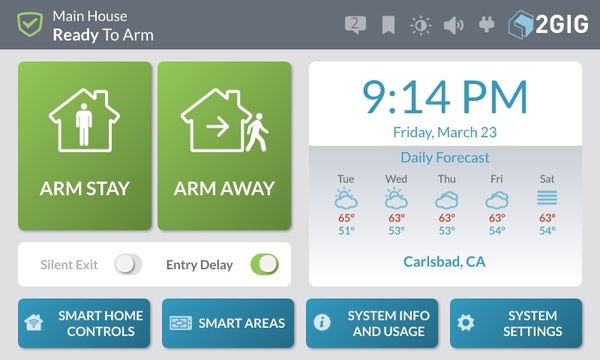Clarification on Wireless Range of PowerG Sensors
Posted By Michael GorisWe have recently been made aware that the maximum range for the DSC 915 MHz PowerG Sensors is only 2,000 feet in open air when used with the IQ Panel 2 Plus. This is quite shorter than the 2 kilometer maximum range when these same sensors are used with DSC PowerSeries Neo Alarm Systems.
 Through testing, we have determined that the range of PowerG Sensors is noticeably shorter when they are used with a Qolsys IQ Panel 2 Plus instead of with a DSC PowerSeries Neo. This is likely due to the smaller antenna that is featured on the IQ Panel 2 Plus System. On a DSC PowerSeries Neo System, the sensors can achieve their advertised wireless range of up to 2km in open air. But the IQ2+ offers a considerably smaller wireless range, even with clear line of sight. The maximum range for a PowerG Sensor used with an IQ Panel 2 Plus is no more than 2,000 feet. This is much less than 2km. We also do not recommended trying to use the Power Sensors with an IQ2+ beyond 500 feet away in practice. This is especially true if many obstacles and walls are present.
Through testing, we have determined that the range of PowerG Sensors is noticeably shorter when they are used with a Qolsys IQ Panel 2 Plus instead of with a DSC PowerSeries Neo. This is likely due to the smaller antenna that is featured on the IQ Panel 2 Plus System. On a DSC PowerSeries Neo System, the sensors can achieve their advertised wireless range of up to 2km in open air. But the IQ2+ offers a considerably smaller wireless range, even with clear line of sight. The maximum range for a PowerG Sensor used with an IQ Panel 2 Plus is no more than 2,000 feet. This is much less than 2km. We also do not recommended trying to use the Power Sensors with an IQ2+ beyond 500 feet away in practice. This is especially true if many obstacles and walls are present.
Previously, we produced content that led some customers to believe that the maximum range of these sensors was 2km when used with the IQ2+. We have since learned that this is not the case, and we have adjusted our old content accordingly. These changes apply to all versions of the IQ Panel 2 Plus, regardless of which legacy daughtercard or cellular communicator is used. We apologize for any inconvenience that this may have caused for our customers.
The only way these sensors can support a 2km signal range is when they are used with a DSC PowerSeries Neo System. These systems feature more powerful antennas that can allow these sensors to achieve their maximum possible distance. Alarm Grid does not sell any PowerSeries Neo Systems at this time, but we do offer compatible Alarm.com cellular communicators that allow us to takeover these systems.
That being said, 2,000 feet of open air range is still extremely impressive for any alarm system. Even customers with the largest of homes and should be able to utilize these sensors as they see fit. And if the range still isn't enough, a PowerG wireless repeater can be used to effectively double the range. This will boost it to more than 1,000 feet when used in most homes and up to 4,000 feet when used with an IQ Panel 2 Plus in open air!
Additionally, we've found that these sensors cannot auto-enroll with an IQ Panel 2 Plus like most other compatible sensors. Instead, the Serial Number for the sensor must be manually entered. For the PowerG Sensors, this is called the "DL ID", and it can be found on the sensor's box. The user must also set the Source Signal to reflect that of PowerG. Please keep this in mind when enrolling a PowerG Sensor with an IQ Panel 2 Plus Alarm System.
UPDATE: We have since learned that you can auto-enroll PowerG Sensors with the IQ Panel 2 Plus. This post explains the process.

If you have any questions about the IQ Panel 2 Plus or DSC PowerG Sensors, please do not hesitate to reach out to us. You may email us at any time at support@alarmgrid.com, or you can call us from 9am to 8pm EST M-F at 888-818-7728. We look forward to helping you with your security needs!

 If you aren't familiar with
If you aren't familiar with 

















